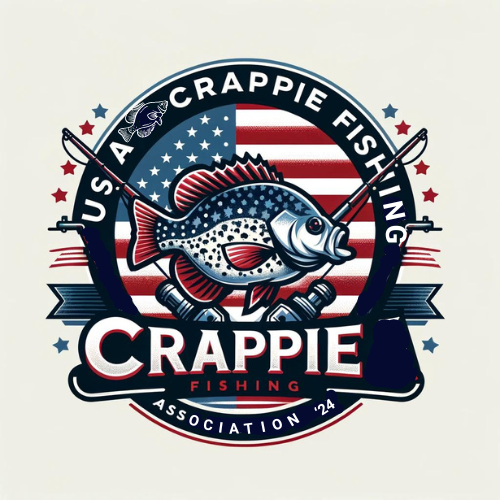I have always been fascinated by the excitement of crappie fishing. There’s something exhilarating about being out on the water, witnessing a feeding frenzy unfold right before your eyes. The water comes alive as crappie swim in a tight school, darting and feeding with reckless abandon. It’s a sight that every fishing enthusiast should experience.
Crappie fishing is not just about the thrill of the catch but also understanding the behavior of these elusive fish. By mastering the right techniques and gaining knowledge about their feeding habits, you can increase your chances of success and truly become a part of the action.
Key Takeaways
- Witnessing a crappie feeding frenzy is a thrilling experience for any angler.
- Understanding crappie feeding behavior is essential for successful fishing.
- Choosing the right fishing techniques can make a difference in your catch rate.
- Crappie can be found in a variety of habitats, from lakes to rivers.
- Targeting crappie during their spawning season can lead to high action and successful fishing trips.
Understanding Crappie Feeding Behavior
When it comes to crappie fishing, understanding their feeding behavior is crucial for success. Crappie are known for their opportunistic feeding habits and often gather in schools. They have a voracious appetite and can go on a feeding frenzy when the conditions are just right.
To attract crappie and increase your chances of a successful fishing trip, it’s important to choose the right lures that mimic their natural prey. By selecting lures that closely resemble the baitfish crappie feed on, you can effectively entice them to strike.
When it comes to lure selection for crappie fishing, there are a few key factors to consider:
- Lure Size: Choosing the right size lure is essential. A good rule of thumb is to match the size of the lure to the size of the baitfish crappie are feeding on. If you notice that crappie are targeting smaller baitfish, opt for smaller lures.
- Lure Color: The color of the lure can also play a significant role in attracting crappie. In clear water, natural colors like chartreuse, white, and silver often work well. In murky water, brighter colors like yellow, red, and orange can be more effective in catching the attention of crappie.
- Lure Action: Consider the action of the lure. Crappie are attracted to lures that mimic the movement of their prey. Lures with subtle twitches, wiggles, or vibrations can be particularly enticing to crappie.
Experimenting with different lure types, sizes, colors, and actions can help you determine what works best for the specific conditions and preferences of the crappie in your area.
Remember, crappie can be highly selective in their feeding behavior, so don’t be afraid to switch things up if one approach isn’t yielding results. Pay attention to the underwater signs, such as baitfish activity or feeding activity near structure, to optimize your lure selection for crappie fishing.
Observing and understanding crappie feeding behavior is key to becoming a successful crappie angler. By selecting the right lures that mimic their natural prey and paying attention to the nuances of their feeding habits, you can enhance your chances of landing a trophy crappie.
Crappie Habitats and Best Fishing Spots
When it comes to crappie fishing, understanding their habitats and knowing the best fishing spots can greatly increase your chances of success. Crappie are versatile fish and can be found in a variety of habitats, including lakes, ponds, and rivers.
One key factor in finding crappie is their preference for submerged structures. They often gather near fallen trees, brush piles, and docks, using these structures as cover and feeding grounds. These areas provide them with protection from predators and an abundance of food.
If you’re looking for the best fishing spots for crappie, there are a few key locations to consider:
- Shallow Bays: Shallow bays are prime fishing spots, especially in the early morning and late evening. Crappie are known to move into these areas to feed, especially during the spring spawn. Look for areas with weeds or submerged vegetation, as these can attract crappie.
- Weed Beds: Crappie are often found near weed beds, as these areas provide cover and attract smaller baitfish. Look for areas with dense vegetation, such as lily pads or hydrilla, and focus your fishing efforts around these areas.
- Areas with Underwater Vegetation: Crappie are also attracted to areas with underwater vegetation, such as submerged grass or moss. These areas can provide a steady food source and attract smaller fish, which in turn attract crappie. Look for these areas and fish around the edges where the vegetation meets open water.
Knowing the preferred habitats and best fishing spots for crappie can give you a significant advantage on your fishing trips. By targeting these areas and using the right techniques, you’ll increase your chances of landing a trophy crappie.
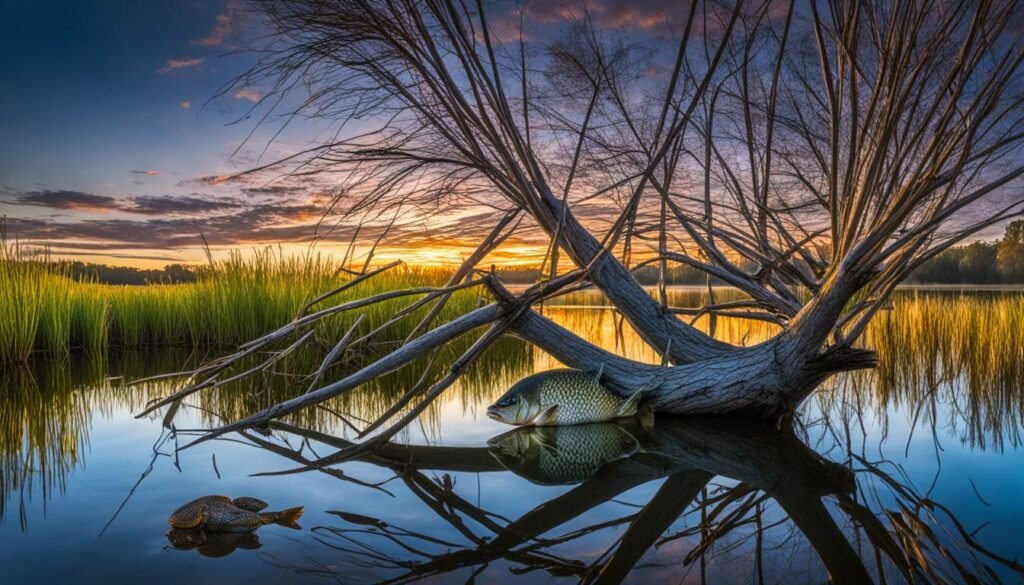
Next, I’ll share some techniques for catching crappie and provide tips for a successful fishing trip.
Techniques for Catching Crappie
When it comes to crappie fishing, employing the right techniques can make all the difference between a successful catch and a disappointing outing. In this section, I will discuss some tried and true techniques that will help you maximize your chances of landing those elusive crappie. Additionally, I will provide insights on lure selection, an essential aspect of crappie fishing that can significantly increase your chances of success.
Jigging
Jigging is one of the most popular and effective techniques for targeting crappie. It involves using a jig, typically a small weighted hook with a soft plastic body, to mimic the movement of a baitfish. By imparting a subtle motion to the jig with gentle twitches of your rod, you can entice crappie into striking. Jigging allows you to cover a wide area and explore different depths, making it suitable for both shallow and deep-water situations.
Casting
Casting is another versatile technique that can be employed to catch crappie. By casting your lure near structures such as fallen trees, docks, or weed beds, you can entice crappie that are seeking cover or hunting for prey. Light to medium-weight spinning gear is commonly used for casting, paired with lures such as small crankbaits, spinners, or soft plastics. Casting allows you to target specific areas and present your lure in a realistic manner.
Bobber Fishing
Bobber fishing, also known as float fishing, is a popular technique for crappie fishing, especially in shallow water or when targeting suspended crappie. By attaching a bobber to your line and suspending your bait at a desired depth, you can present your lure perfectly in the strike zone. Bobber fishing is often combined with live bait such as minnows or worms, providing a tempting meal for crappie.
Now that we’ve covered some of the primary techniques for catching crappie, let’s delve into the crucial aspect of lure selection. Choosing the right lure is essential for enticing crappie to bite and increasing your chances of success.
Lure Selection
When selecting lures for crappie fishing, it’s important to opt for ones that closely resemble the baitfish crappie feed on. By imitating their natural prey, you can trigger their predatory instincts and elicit strikes. Here are some popular lure options for crappie:
- Minnow Imitations: These lures replicate the appearance and movement of live minnows, which are a staple in the diet of crappie. They come in various shapes, sizes, and colors, allowing you to match the forage in different fishing conditions.
- Jigs: Jigs are versatile and effective lures for crappie fishing. They consist of a weighted head and a soft plastic body, which can be customized with different colors and patterns. Jigs can be fished at varying depths and in different presentations, making them a go-to lure for crappie anglers.
- Soft Plastics: Soft plastic baits, such as tubes, grubs, and worms, can be extremely effective for enticing crappie. They offer a lifelike action and can be rigged in different ways to imitate various baitfish or invertebrates that crappie feed on.
By experimenting with different lures and techniques, you can find what works best in your fishing area and adapt to the preferences of the crappie. Remember to vary your retrieves, depths, and locations until you find a winning combination.
Now that you have a good understanding of the techniques for catching crappie and the importance of lure selection, you’re well-equipped to venture out and hook into some fantastic crappie action. In the next section, we’ll explore the thrilling world of the spring crappie spawn invasion, a prime time for targeting these prized fish.
The Spring Crappie Spawn Invasion
Crappie fishing enthusiasts eagerly await the arrival of spring for one crucial event: the crappie spawn. As water temperatures rise to around 56-60 degrees Fahrenheit, male and female crappie engage in a massive reproductive frenzy, creating an incredible opportunity for anglers to reel in abundant catches. This is the time when crappie can be found concentrated in shallow-water areas, making it ideal for spring crappie fishing.
During the spawn, male crappie create nests by fanning the lake or river bottom with their fins, clearing a small depression where the females can deposit their eggs. After the eggs are laid, the male crappie guards the nest until the eggs hatch. This fascinating behavior not only makes for an interesting spectacle but also sets the stage for great fishing action.
To take advantage of this unique fishing phenomenon, it’s important to understand the behavior and preferences of spawning crappie. During this time, crappie become more aggressive and are highly receptive to bait and lures. Anglers can strategically position themselves near crappie nesting areas and effectively target these fish with various techniques.
Targeting Crappie Nesting Areas
Identifying crappie nesting areas can significantly increase fishing success during the spawn. Look for shallow areas with structure, such as submerged trees, stumps, or vegetation, where crappie prefer to spawn. Pay attention to any signs of crappie activity, such as males aggressively guarding nests or fish chasing each other around shallow water.
Furthermore, it’s essential to be aware of the water temperature as it directly impacts crappie spawning behavior. Using a reliable thermometer, measure the temperature in different parts of the lake or river to find the areas where water temperatures reach the ideal range for spawning. Warm, dark-bottom bays are often hotspots for crappie nesting.
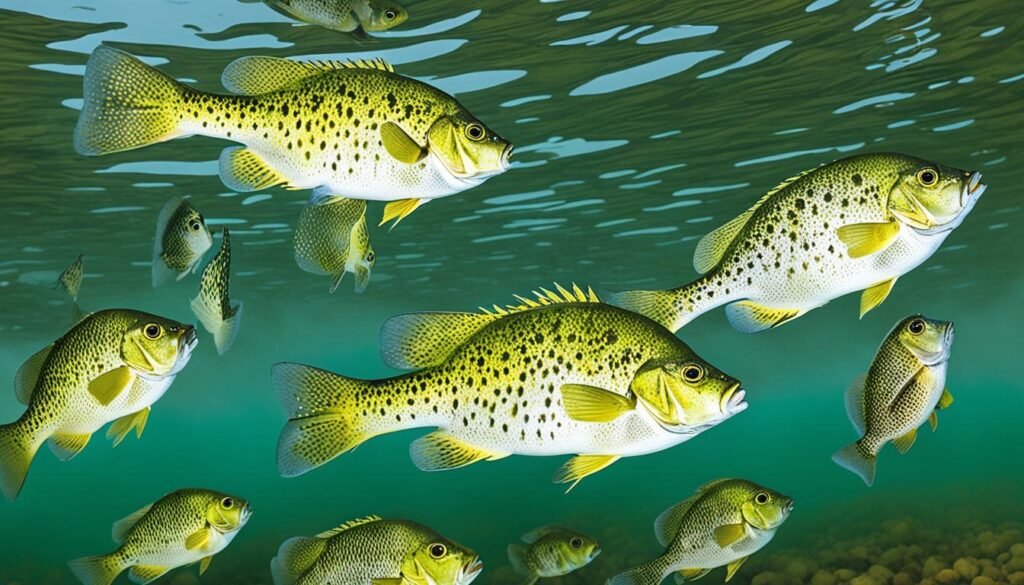
Techniques for Spring Crappie Fishing
When targeting crappie during the spawn, it’s crucial to adjust your fishing techniques accordingly. Here are some recommended techniques that can yield excellent results:
- Jigging: Use small jigs in natural colors, such as bright green or chartreuse, to mimic crappie’s natural prey. Cast near the nesting areas and make subtle, erratic movements to entice the fish.
- Slip bobber fishing: Rig a slip bobber with a small live minnow or a crappie jig below it. Set the depth of the bait to match the crappie’s feeding zone and watch for any bobber movement.
- Trolling: If the spawning area is large, consider trolling with small crankbaits or feather jigs to cover more water and find active fish.
Experimenting with different techniques and adjusting your presentation based on the behavior of the crappie can be the key to enticing bites and maximizing your catch during the spring crappie spawn.
“The spring crappie spawn presents an extraordinary opportunity for anglers to witness and participate in the natural reproductive cycle of these fish. It’s a thrilling time to be on the water, as you’ll have a chance to catch trophy-sized crappie in abundance.”
Stay tuned for the next section, where I’ll share valuable tips to ensure your spring crappie fishing adventures are successful.
Tips for Successful Crappie Fishing
When it comes to crappie fishing, there are a few tips and techniques that can greatly improve your chances of success. From understanding the importance of water temperature to selecting the right equipment, here are some valuable insights to enhance your crappie fishing experience.
1. Consider Water Temperature and Conditions
The temperature of the water plays a crucial role in the activity and behavior of crappie. As a general rule, crappie become more active and eager to feed when the water temperature is between 55-65°F (12-18°C). Warmer water temperatures signal spawning season, while cooler temperatures can slow down their feeding patterns. Additionally, weather conditions such as wind and cloud cover can also impact their behavior.
2. Time Your Fishing Trips
Knowing the best time of day to fish for crappie can significantly increase your chances of a successful outing. Crappie are known to be more active during low-light periods, such as early morning and late afternoon. The combination of reduced sunlight and cooler temperatures during these times can entice crappie to feed more aggressively.
3. Choose the Right Equipment
Having the right equipment is essential for crappie fishing. Opt for light or ultra-light rods and reels, as crappie have delicate mouths and can easily detect heavy lines. Lighter tackle allows for a more sensitive feel, making it easier to detect subtle bites. Additionally, using fluorocarbon or monofilament lines with a low visibility factor can also improve your chances of fooling crappie into biting.
4. Master Your Crappie Bait Selection
Choosing the right bait is paramount when targeting crappie. It’s essential to understand the prey that crappie typically feed on, such as small minnows, insects, and tiny crustaceans. Matching your bait selection to their naturally occurring forage can make a significant difference in your catch rate. Commonly used baits include jigs, minnows, soft plastics, and small spinners or spoons.
5. Utilize Effective Crappie Fishing Techniques
Employing the right fishing techniques can greatly improve your crappie fishing success. One popular technique is vertical jigging, where you lower your baited jig down to specific depths and gently jig it up and down to entice crappie to bite. Another technique is casting and retrieving small crankbaits or spinnerbaits along submerged structures, mimicking the movement of prey. Experimenting with different techniques can help you find what works best for the current conditions and the preferences of crappie in your fishing spot.
“To have a successful crappie fishing trip, it’s important to consider factors such as water temperature, time of day, and weather conditions. Using the right equipment and bait, along with mastering effective fishing techniques, can greatly increase your chances of catching crappie.”
| Crappie Fishing Tips | Crappie Fishing Techniques |
|---|---|
| Consider water temperature and conditions. | Vertical jigging |
| Time your fishing trips. | Casting and retrieving small crankbaits or spinnerbaits. |
| Choose the right equipment. | Experiment with different techniques. |
| Master your crappie bait selection. |
By considering these tips and techniques, you can increase your chances of a successful crappie fishing trip. Remember to always practice ethical angling and follow local fishing regulations to help preserve the crappie population for future generations.
Crappie Fishing During Ice-Out
As the ice melts in the early spring, it’s an exciting time for crappie anglers. Ice-out crappie fishing provides a unique opportunity to catch these prized fish near the shoreline. The transition from winter to spring triggers a change in the behavior of crappie, making them more active and willing to feed. With the right techniques and equipment, you can have a successful early ice-out crappie fishing trip.
Wading and fishing along the shoreline is a productive strategy during ice-out. Crappie tend to follow the retreating ice and congregate in shallow water near the shore. They can be found near submerged structures, such as fallen trees and brush piles, providing cover and ambush points for feeding. By casting along the shoreline and targeting these structure-rich areas, you increase your chances of hooking into crappie.
Using artificial lures is effective for enticing crappie during ice-out. Jigs and slip bobber rigs are popular choices among anglers. Jigs mimic the movement of minnows, one of the primary food sources for crappie, while slip bobbers allow you to suspend your bait at a specific depth. Experiment with different colors and sizes to find what works best for the current conditions and the preferences of the crappie.
When fishing during ice-out, it’s important to pay attention to water temperature and weather conditions. As the ice melts, the water temperature starts to rise, which triggers crappie to become more active. A slight increase in temperature can make a big difference in the behavior and feeding patterns of the fish. Additionally, overcast days or low-light conditions can provide ideal fishing opportunities, as crappie tend to be more active during these times.
Early ice-out crappie fishing presents a unique challenge and an exciting chance to catch these tasty fish. The combination of the changing season, shallow water, and hungry crappie creates a recipe for success. With the right tactics and a bit of patience, you can make the most of this thrilling fishing opportunity.
The Thrill of Crappie on the Line
Fishing for crappie can be an exciting and thrilling experience, especially when you hook into a big one. Crappie are known for their hard fights and acrobatic jumps, making them a popular species among anglers.
“Crappie fishing is like a rollercoaster ride on the water. The moment you feel that tug on your line, the adrenaline rush kicks in, and you know you’re in for a wild ride. Crappie put up a tremendous fight, darting and diving, testing your skills and gear to the limit. It’s an exhilarating experience that keeps anglers coming back for more.”
Whether you’re a seasoned angler or just starting out, the fast black crappie action will keep you on your toes. These feisty fish will test your tackle and require finesse to reel in. The thrill of the chase and the anticipation of landing that trophy-sized crappie is what makes this sport so addictive.
When you’re out on the water, every moment counts. The quick and agile movements of crappie demand your full attention. From the initial strike to the battle to bring it aboard, crappie fishing provides an intense and engaging experience that keeps anglers hooked.
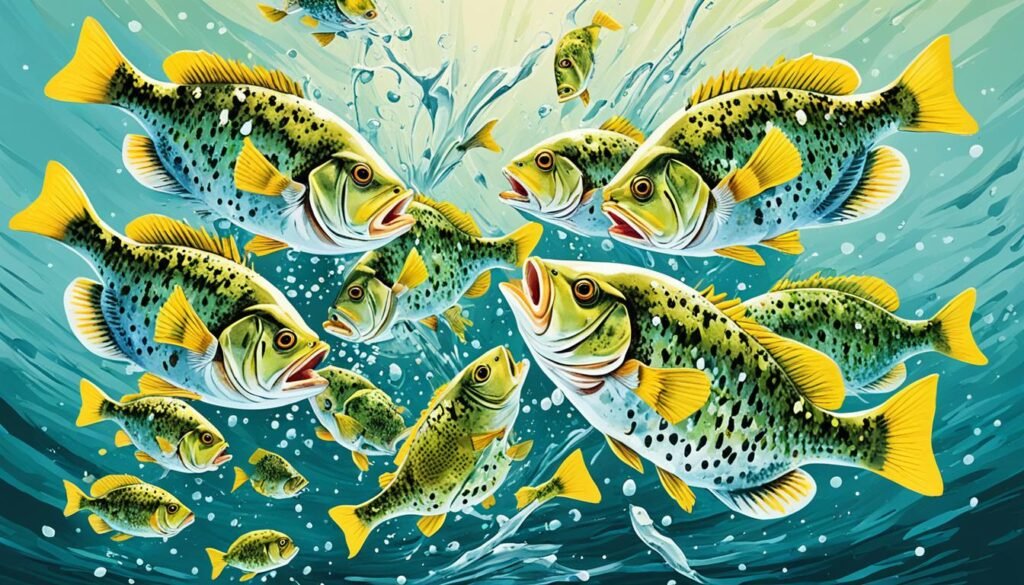
Crappie on the Line: A Test of Skills
When you feel the bite and set the hook, the adrenaline rush takes over. Crappie will put up a fight, testing your angling skills and gear. Their acrobatic jumps and sudden bursts of speed will leave you breathless.
Reeling in a crappie requires finesse and patience. You must work the fish, tire it out, and carefully maneuver it toward the net. The battle between angler and fish is a true test of skills and determination.
And when you finally bring that crappie aboard, the sense of accomplishment is unmatched. The satisfaction of a battle well-fought and a beautiful fish in your hands is what crappie fishing is all about.
| Crappie Action | Description |
|---|---|
| Hard Fights | Crappie are known for their aggressive fights, testing your angling skills and strength. |
| Acrobatic Jumps | Crappie can leap out of the water, showcasing their agility and making for thrilling moments on the line. |
| Strong Runs | These fish can make sudden bursts of speed, challenging your ability to reel them in. |
| Unpredictable Behavior | Crappie have a knack for surprising anglers with their unpredictable movements, keeping you on your toes. |
So, whether you’re a fan of the heart-racing action or simply enjoy the thrill of the catch, crappie fishing is an experience like no other. Get out on the water, feel the excitement, and join in on the fast black crappie action!
Preferred Techniques for Spring Crappie Fishing
In the spring, crappie can be found in shallow, dark-bottom bays where the water is warmest. To maximize your success during this time, it’s important to utilize the right techniques and equipment. Two popular methods for spring crappie fishing are using jigs and slip bobbers.
Using Jigs for Spring Crappie Fishing
Jigging is a tried and true technique for catching crappie, especially during the spring. Jigs are versatile lures that can imitate a variety of baitfish, making them highly effective for enticing crappie to bite. When selecting jigs, opt for lighter colors such as white, chartreuse, or yellow, as they tend to attract crappie in murky water.
When jigging, cast your line near structure such as fallen trees or submerged brush piles, as crappie often seek cover in these areas. Allow the jig to sink to the desired depth, then use a slow and steady retrieve, imparting subtle twitches and pauses to mimic the movement of injured prey. Pay close attention to any subtle taps or line movement, as this may indicate a crappie bite.
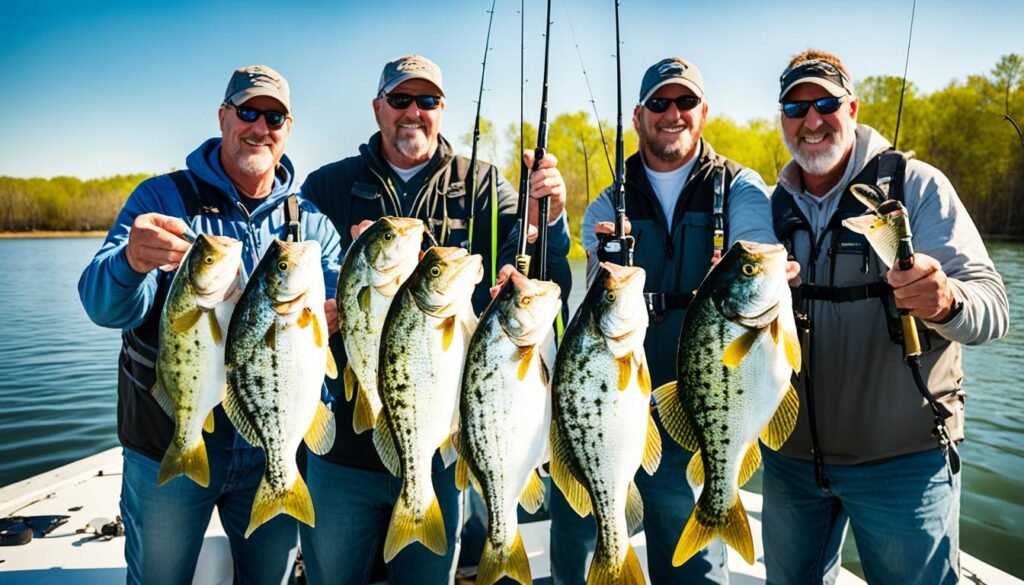
Slip Bobber Fishing for Spring Crappie
Another effective technique for spring crappie fishing is using slip bobbers. Slip bobbers allow you to target specific depths where crappie may be feeding, making them highly efficient for locating active fish. They are especially useful when fishing near submerged structures or in areas with varying depths.
To set up a slip bobber rig, thread your fishing line through the slip bobber stop and bead, then tie on a small hook. Attach a split shot sinker a few inches above the hook to provide weight and maintain stability. Cast your rig near potential crappie hotspots and allow the bait to suspend at the desired depth. By adjusting the slip bobber stop, you can easily modify the depth at which your bait is presented.
When using slip bobbers, it’s important to create some enticing movement. Gently twitch your rod tip or give the line a quick pop to create subtle vibrations in the water, which can attract curious crappie. Keep a close eye on your slip bobber for any sudden movements, as this could indicate a crappie has taken the bait.
Pro Tip: Experiment with different jigging techniques and slip bobber depths to find what works best for the specific conditions and location you are fishing in. The key is to be patient, observant, and willing to adapt your approach based on the behavior and preferences of the crappie in the area.
By employing these preferred techniques for spring crappie fishing, you can increase your chances of landing a prized catch. Whether you choose to jig or use slip bobbers, remember to stay in tune with the feeding patterns of crappie and adjust your techniques accordingly. Now that you’re armed with the knowledge and techniques to target crappie during the spring, you’re ready to hit the water and experience the thrill of reeling in these prized game fish!
Timing is Key for Spring Crappie Fishing
When it comes to spring crappie fishing, timing plays a crucial role in your success. Understanding the spawn timing of crappie is essential for planning your fishing trips and maximizing your chances of landing a catch.
Crappie typically spawn when water temperatures reach around 56-60 degrees Fahrenheit. This usually occurs during the spring months. The spawning process can last for several weeks, offering anglers an extended window of opportunity to target these fish.
By monitoring water temperature and observing spawning signs, you can determine the prime time to go spring crappie fishing. Keep an eye out for crappie nests, which appear as circular depressions on the lake or river bottom. Male crappie prepare these nests by clearing away debris and creating a suitable environment for spawning.
During the spawn, crappie become more active and aggressive, which increases your chances of success. They can be found in shallower water near their nesting sites. This is the perfect time to cast your line and lure in the preoccupied crappie.
Signs of Crappie Spawning Activity:
- Males guarding nests
- Frequent surface splashing
- Audible popping sounds (males defending their nests)
By paying attention to these signs and aligning your fishing efforts with the spawn timing, you can significantly improve your spring crappie fishing experience.
| Month | Water Temperature (Fahrenheit) | Crappie Spawn Activity |
|---|---|---|
| March | 50-55 | Pre-spawn movements, getting closer to nesting areas |
| April | 56-60 | Main spawning period, active nest building and mating |
| May | 61-65 | Post-spawn, transitioning to summer patterns |
Quick Tips for Spring Crappie Fishing:
- Pack your fishing gear and hit the water when the water temperature approaches 56-60 degrees Fahrenheit.
- Look for signs of crappie nesting activity, such as males guarding nests and surface splashing.
- Focus on the shallow-water areas near the spawning sites.
- Use lures and baits that imitate crappie’s natural prey, such as minnow imitations and jigs.
- Experiment with different retrieval speeds and techniques to find what works best on that day.
Conclusion
Witnessing a crappie feeding frenzy is an incredible experience for any angler. To increase your chances of success on the water, it’s important to understand crappie feeding behavior and implement effective strategies. By targeting their preferred habitats and using the right techniques, you can maximize your catch and have a memorable fishing trip.
When it comes to crappie fishing, there are several tips to keep in mind. First, choose lures that closely mimic their natural prey to attract their attention. Jigs, minnow imitations, and soft plastics are all effective options. Second, consider the water temperature, time of day, and weather conditions as these factors can influence crappie behavior and feeding patterns.
Lastly, practicing catch and release is crucial for the sustainability of crappie populations. By releasing the fish back into the water, you contribute to the conservation efforts and ensure future generations of anglers can enjoy this exhilarating sport. So, grab your gear, apply these crappie fishing tips, and get ready to witness the thrill of a crappie feeding frenzy!
